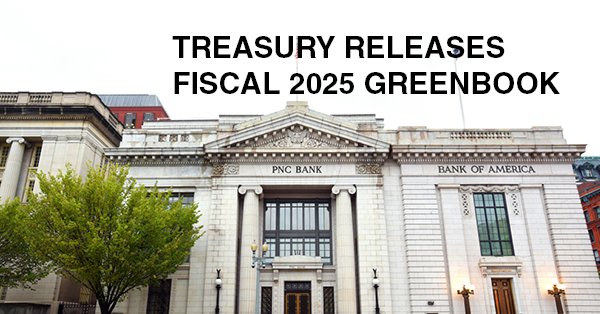TREASURY RELEASES FISCAL 2025 GREENBOOK:

What is the “Green Book?”
The President's Budget, often referred to as the "Green Book" due to its traditional green cover, is an annual budget proposal submitted by the President of the United States to Congress. This comprehensive document outlines the President's budgetary priorities, including proposed expenditures, revenue projections, and policy initiatives for the upcoming fiscal year.
The Green Book typically includes detailed information on various government agencies and programs, including their funding requests and proposed policy changes. It serves as a blueprint for federal spending and reflects the President's policy agenda and priorities.
Congress uses the President's Budget as a starting point for the budgetary process, but it has the authority to modify, approve, or reject the proposals outlined in the document. The budgetary process involves negotiations between the President and Congress to finalize spending priorities and enact appropriations bills to fund government operations.
What is included in this year’s Greenbook?
- It includes familiar revenue raisers and expanded health and retirement programs
- Increased rates and expanded brackets for high-earners
- Increased corporate rates
- Changing US international tax rules to align with Pillar 2
- It also retreads ground on closing loopholes and expanding the social safety net
- Making expanded heath care premium support permanent
- Restoring the child tax credit
Adjusting requirements for retirement accounts and distributions
| PROPOSAL: | 10-YEAR REVENUE EFFECT |
|---|---|
| Increase corporate tax rate to 28%, from 21% | $1,349.9B |
| Raise the additional Medicare tax for high-income households to 5%, from 3.8%; change how tax applies to certain passthrough income |
797.0 |
| Impose 25% minimum tax on total income on wealthiest 0.01% of taxpayers | 502.7 |
| Overhaul international tax system, including increasing tax rate on US multinationals’ foreign earnings to 21%, from 10.5% | 373.9 |
| Change taxation of capital gains income | 288.6 |
| Increase top marginal income tax rate to 39.6%, from 37%, for individuals earning more than $400,000, or more than $450,000 for joint filers | 245.9 |
| Increase excise tax on repurchase of corporate stock buybacks to 4%, from 1% | 166.0 |
| Adopt the undertaxed profits rule | 136.3 |
| Eliminate various fossil fuel tax incentives | 35.3 |
| Impose digital asset mining energy excise tax | 7.7 |
| Tax carried interest as ordinary income | 6.6 |
Additional proposed tax benefits for individuals include:
- Budget would provide two refundable tax credits for homebuyers:
- First-time homebuyer tax credit and home seller credit would be equal to 10% of the home's price, to a maximum credit of $10,000.
- Both would phase out with modified adjusted gross income exceeding $100,000
- Credit would fully phase out at AGI of $200,000.
- The budget proposal would fully restore the Child Tax Credit for 2024 and 2025:
- $3,000 per child for children six and older
- $3,600 per child for children under six
- A portion of the credit would phase down at certain income levels, depending on the filer:
- Modified AGI above $150,000 for married joint filers or surviving spouses
- Modified AGI above $112,500 for head of household filers
- Modified AGI above $75,000 for all other filers (with a modified rule for large families)
From the Editor: it is important to note that these are only proposed changes from the President’s wish list. What Congress will eventually take up and include in future legislation is unknown.




